Chemtrails
A
Field Guide to Chemtrails
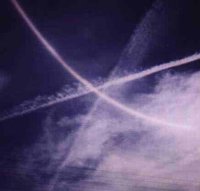 Chemtrails
are a new phenomena which has struck all over the world. It seems that the government
are using planes to spray populated areas with a chemical solution, which can
make people very sick, but why??. Normal contrails usually dissipate very rapidly,
are of relatively short length, and show variability in their formation from
the engines. Chemtrails usually extend continuously and expand to transform
into a cirrus type cloud layer. Apart from the repeated, intense, and unusual
flight-patterns, odd illnesses will sometimes strike people shortly after these
chemtrail episodes; multiple witnesses have also reported a cobweb-like substance
seen falling from the sky.
Chemtrails
are a new phenomena which has struck all over the world. It seems that the government
are using planes to spray populated areas with a chemical solution, which can
make people very sick, but why??. Normal contrails usually dissipate very rapidly,
are of relatively short length, and show variability in their formation from
the engines. Chemtrails usually extend continuously and expand to transform
into a cirrus type cloud layer. Apart from the repeated, intense, and unusual
flight-patterns, odd illnesses will sometimes strike people shortly after these
chemtrail episodes; multiple witnesses have also reported a cobweb-like substance
seen falling from the sky.
You
should also know that a lab-analysis of some "goo" which fell to the ground
revealed the presence of biological-agents: Pseudomonas Fluorescens, Streptomyces,
and a restriction enzyme used to create viruses. Further, a gentleman
who has been following the contrails around the country for years had
a medical test which discovered pathogens in his body -- the rare V2 Grippe
virus among them -- pathogens that should only be found in laboratories.
During
the past several months, investigators across the United States and Canada have
been collecting photographs and eyewitness accounts related to a widespread,
ongoing, and strangely anomalous phenomena that has been occurring in our skies
overhead. We are referring to the purposeful, deliberate weaving of strange,
lingering, and thickening aerial contrails, better known as ChemTrails
to most observers. Most persons viewing these photographs and reading the associated
accounts have had little difficulty arriving at the obvious conclusion that
these documented aerial phenomena represent anything but the normal
contrail activity associated with everyday commercial airline traffic.
To most
observers, the feeling that there is something disturbing, and even ominous, connected
with these images and reports, has been more than just a passing impression or
a temporary distraction. Those of us who have yielded to our natural human curiosity
and taken the time to turn off the TV, go outside, and look up into the sky, have
been rewarded with a stunning first-hand observation of these strange phenomena.
This undeniable personal experience has provided more than the reasonable and
sufficient amount of evidence required to lead many observers to the startling
conclusion that there is currently, an ongoing, nationwide, government project
underway across America and other countries. At present, neither the purpose nor
the scope of this operation is fully understood. Two facts are known however—that
this strange contrail activity is not a normal, ordinary, or every-day phenomena,
and that this program, which seems to have entered its operational phase during
the fall of 1998, is being simultaneously, repeatedly, and continuously executed
over virtually every populated community in the United States.
A
Contrail Is Not A ChemTrail
ChemTrails
are not the same as normal, everyday aerial contrails; there is a definite observable
difference in both the formation and behavior of these two similar phenomena,
which clearly distinguishes one from the other.
Normal
contrails are composed of fragile ice crystals formed by aircraft flying at
altitudes of 31,000 feet or greater. At altitudes below 31,000 feet, these normal
vapor condensation trails are simply not able to form behind an aircraft, regardless
of its type or design. Above 31,000 feet, normal contrails appear pencil-thin
in construction when observed from ground level, and in nearly all instances,
tend to totally evaporate within a minute or so, rarely extending for any appreciable
distance behind the emitting aircraft.
ChemTrails
on the other hand, have been observed being generated by aircraft flying at
altitudes as high as 33,000 feet and as low as 8,000 feet—but generally, below
30,000 feet. Since normal contrails can not form at these low altitudes, any
contrail formation that is observed at these elevations is probably not a contrail
at all, but a genuine ChemTrail.
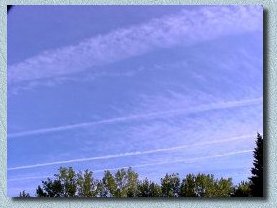 These
normally manifest as billowy smoke trails when viewed from the ground, and tend
to always become broader and denser over time. They generally do not evaporate,
nor do they dissipate at all. Over a period of several hours, parallel ChemTrail
formations will eventually spread out to meet one another and join together to
form a continuous, banded, cirrus-like cloud formation in the sky. Often a fish-spine
configuration will be observed after a given ChemTrail has had sufficient time
to mature. Shortly after this joining-up phase, what just hours earlier was a
perfectly clear blue sky, will now appear as a structured, milky-haze overcast,
unnatural in all respects.
These
normally manifest as billowy smoke trails when viewed from the ground, and tend
to always become broader and denser over time. They generally do not evaporate,
nor do they dissipate at all. Over a period of several hours, parallel ChemTrail
formations will eventually spread out to meet one another and join together to
form a continuous, banded, cirrus-like cloud formation in the sky. Often a fish-spine
configuration will be observed after a given ChemTrail has had sufficient time
to mature. Shortly after this joining-up phase, what just hours earlier was a
perfectly clear blue sky, will now appear as a structured, milky-haze overcast,
unnatural in all respects.
Another
distinguishing difference between contrails and ChemTrails concerns their relative
location or position in the local sky, as well as their directional characteristics.
Aircraft
emitting normal contrails are constrained by FAA regulations to operate only
over designated air routes; therefore, the contrails that they generate will
be found consistently only within local flight corridors, which are easily discerned
by an observer at any given geographic location on the ground. In addition,
air traffic along these designated routes is always unidirectional. Aircraft
flying in opposing compass directions are never permitted to use the same air-routes,
at the same altitudes—for obvious reasons. Therefore, only those contrails that
are formed within these restricted air corridors, and consistently with the
same vector or direction should be considered normal contrails resulting from
normal commercial airline traffic.
There
is one exception to this rule however. Occasionally, normal contrails will be
emitted by military air traffic, which do not always operate within these flight
corridor constraints. This deviation is due to the fact that the military is
generally exempt from commercial flight regulations during air maneuvers and
training exercises—but again, this is the exception and not the rule.
Aircraft
that generate ChemTrails are apparently not constrained to operate within FAA
designated air corridors either; nor are they required to adhere to established
commercial flight rules and FAA regulations. Consequently, ChemTrail patterns
will be observed lying both within and well outside of the normal air corridors
used by the commercial airlines. Unlike normal contrails, these lattice formations
can and do appear at any location in the local sky, develop in
any geographic direction or vector, intersect and intercept one another as a
matter of practice, and produce elaborate and extensive cross-hatch or geometric
patterns, which are often seen extending from horizon to horizon. Any commercial
airliner that attempted to engage in these kinds of flight maneuvers would be
guilty of violating just about every known international flight regulation of
commercial aviation. The ChemTrail patterns laid-down by these regulation-exempt
aircraft, generally appear as either long parallel billowing furrows in the
sky, as some variant of an intersecting tic-tac-toe configuration or a simple
figure X.It is believed that these clearly discernible geometric
patterns are used as a means of identifying specific local ChemTrail formations,
and facilitate the tracking of their position, movement, and drift using satellite
telemetry. This information would be vital if it were necessary to determine
critical operational values for the various mission parameters needed to accurately
position these lattice-type networks, so as to target selected geographic locations
and populations with their fallout.
Another
very subtle parameter associated with ChemTrail phenomena is the significance
of the local surface wind speed over the dispersion area. Empirically, ChemTrail
missions tend to be suspended wherever and whenever the ground wind speed reaches
or exceeds 20 miles per hour. This characteristic has been a consistent limiting
factor throughout the range of areas where ChemTrail activity has been observed.
Normal contrail activity is never subject to this restriction, and can be seen
over a wide range of measured surface wind velocities.
One
of the most important distinguishing characteristics of normal contrail formations
is their pattern-configuration. Normal contrails are produced
through a complex interaction between an aircraft's jet engine, its exhaust,
and the temperature and humidity of the ambient atmosphere. Whenever these contrails
are generated, under the proper atmospheric conditions, the number of simultaneous
contrails emitted by any specific aircraft is always directly related to the
engine configuration of that aircraft. A 747, for example, will leave a parallel
four-element contrail in its wake, a DC-10 or L1011, on the other hand, will
emit a parallel three-element contrail, and a 737 or 777 will generate a parallel
two-element contrail in the sky. In each of these cases, the aircraft in question
will generate only short-lived, fully-dissipating, multiple parallel contrails—always,
at altitudes greater than 31,000 feet, and always in accordance with the number
of engines in its design. A multi-engine aircraft will simply not produce single-element
contrails as long as both engines are functioning properly. The number of contrails
therefore, that will be produced by any given aircraft is always the same as
the number of engines powering that aircraft—these numbers are always
equal.
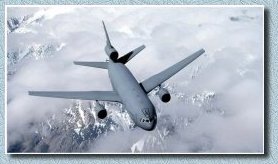 The
type of aircraft that are most frequently observed laying-down genuine ChemTrail
patterns, are normally KC-10A or KC-135 tankers.
The KC-10A is a three-engine aircraft and would therefore normally leave a three-element
parallel contrail in its wake. The KC-135 however, is a smaller, four-engine
aircraft, and would therefore typically display four-element contrail. When
used during ChemTrail missions however, these aircraft have been observed laying-down
only a thick and billowy, single-element ChemTrail, while simultaneously displaying
no concurrent normal contrail activity. Two different mechanisms
are therefore at work here.
The
type of aircraft that are most frequently observed laying-down genuine ChemTrail
patterns, are normally KC-10A or KC-135 tankers.
The KC-10A is a three-engine aircraft and would therefore normally leave a three-element
parallel contrail in its wake. The KC-135 however, is a smaller, four-engine
aircraft, and would therefore typically display four-element contrail. When
used during ChemTrail missions however, these aircraft have been observed laying-down
only a thick and billowy, single-element ChemTrail, while simultaneously displaying
no concurrent normal contrail activity. Two different mechanisms
are therefore at work here.
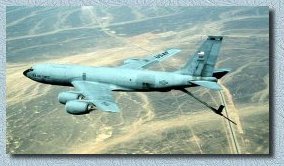 This
pattern-configuration feature can serve as a very good guide in helping to distinguish
between normal contrail observations and true ChemTrails sightings, but it is
not foolproof. The military has been equipping their KC-10As and KC-135s with
wing tip mounted refueling pods, to permit multiple, simultaneous refueling
operations. If one of these aircraft is being used in a particular ChemTrail
mission, then the resulting dispersion will most likely start out as two-parallel
emissions. Eventually though, these will merge into a single wide-band dispersion
pattern, retaining all of the other special characteristics associated with
ChemTrail activity.
This
pattern-configuration feature can serve as a very good guide in helping to distinguish
between normal contrail observations and true ChemTrails sightings, but it is
not foolproof. The military has been equipping their KC-10As and KC-135s with
wing tip mounted refueling pods, to permit multiple, simultaneous refueling
operations. If one of these aircraft is being used in a particular ChemTrail
mission, then the resulting dispersion will most likely start out as two-parallel
emissions. Eventually though, these will merge into a single wide-band dispersion
pattern, retaining all of the other special characteristics associated with
ChemTrail activity.
The
other factor that might be working against this general rule, is the likelihood
that the military is experimenting with a number of different spray-nozzle technologies
having various geometries. Such research would likely be aimed at controlling
the specific flow and dispersion characteristics of their equipment. Variability
in the nozzle designs used to disperse the bio-chemical cocktail, would probably
add some additional variability to the dispersion patterns being observed, but
again, the predominate characteristics of a genuine ChemTrail will eventually
prevail.
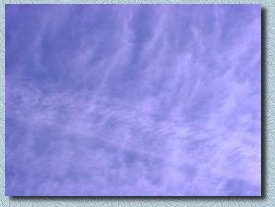 One
more distinguishing characteristic of a ChemTrail than can help to separate
these from normal contrails concerns the display of a vertical curtain-like
fall-off from a maturing ChemTrail. Although the ChemTrail remains very prominent
in the sky, the vertical curtain seems to roll off of the main body and appears
to descend toward the surface in vertical sheets. The
essential idea to keep in mind regarding ChemTrails, regardless of the manner
in which these bio-chemical agents are being dispersed, is that all ChemTrails
eventually coalesce into a consistent, widely diffused footprint, which ultimately
obscures all or most of the entire sky with a clearly structured, solid milky
haze.
One
more distinguishing characteristic of a ChemTrail than can help to separate
these from normal contrails concerns the display of a vertical curtain-like
fall-off from a maturing ChemTrail. Although the ChemTrail remains very prominent
in the sky, the vertical curtain seems to roll off of the main body and appears
to descend toward the surface in vertical sheets. The
essential idea to keep in mind regarding ChemTrails, regardless of the manner
in which these bio-chemical agents are being dispersed, is that all ChemTrails
eventually coalesce into a consistent, widely diffused footprint, which ultimately
obscures all or most of the entire sky with a clearly structured, solid milky
haze.
The
components constituting this bio-chemical soup do not dissipate
or disappear over time; instead, due to the higher specific-gravity of the host
element being used, namely JP8+100 jet fuel, these components simply settle
to the earth and blanket everything within their reach—human beings, animals,
plants, soil, and water, as they slowly descend through the atmosphere—through
the air that we all breath.
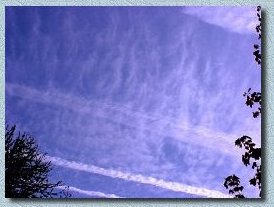 We
can summarize the characteristic pattern-configuration behavioral of genuine
ChemTrail activity with the following two statements: First, that the aircraft
used in these operations tend to be flown at altitudes below 31,000
feet, because no normal engine-related contrails are ever observed concurrent
with the emission of the ChemTrails. Secondly, that the biochemical agent forming
these ChemTrails is being emitted by a mechanical component of the aircraft
other than the engines—normally, this component is the single, extended, rear
mounted, refueling tail-boom.
We
can summarize the characteristic pattern-configuration behavioral of genuine
ChemTrail activity with the following two statements: First, that the aircraft
used in these operations tend to be flown at altitudes below 31,000
feet, because no normal engine-related contrails are ever observed concurrent
with the emission of the ChemTrails. Secondly, that the biochemical agent forming
these ChemTrails is being emitted by a mechanical component of the aircraft
other than the engines—normally, this component is the single, extended, rear
mounted, refueling tail-boom.
There
is one more distinguishing characteristic of unquestionable ChemTrail activity
that we should mention at this time—a very pronounced refractory chemical signature,
visible whenviewing ChemTrail cloud formations illuminated by the sun.
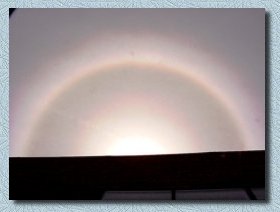 When
sunlight passes through a ChemTrail, the chemical components making up the cloud
tend to refract sunlight in such a way as to render a yellow-orange-green halo
surrounding the sun at a distance of about 20 to 30 degrees of radius on either
side. Some researchers have indicated that this is best observed using polarized
sunglasses, but it can generally be seen with or without a filter. This halo
is not always completely circular and continuous, but may on occasion, depending
on the structure of the ChemTrails, be expressed as colored prominences at irregular,
and scattered distances from the sun.
When
sunlight passes through a ChemTrail, the chemical components making up the cloud
tend to refract sunlight in such a way as to render a yellow-orange-green halo
surrounding the sun at a distance of about 20 to 30 degrees of radius on either
side. Some researchers have indicated that this is best observed using polarized
sunglasses, but it can generally be seen with or without a filter. This halo
is not always completely circular and continuous, but may on occasion, depending
on the structure of the ChemTrails, be expressed as colored prominences at irregular,
and scattered distances from the sun.
A dark-linespectral analysis of the solar spectrum exhibited by
a ChemTrail when illuminated by the sun may also prove particularly useful in
identifying ChemTrail activity, as well as providing valuable information on
its atomic makeup. To date however, we are not aware of any such study or analysis,
although this would seem to be both a reasonable and logical undertaking, well
within the capabilities of most colleges and universities. Perhaps this will
be attempted in the near future. Ethylene dibromide has a mild, sweet odor.
However, just because you do not smell anything peculiar in the air does not
mean that the fallout is not making it all the way to the ground. They are also
using an additive to help camouflage this smell.
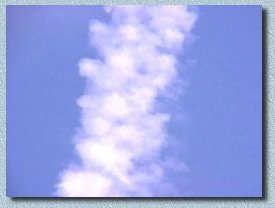 When
the camouflage is not working properly though, or the fallout is particularly
dense, you will definitely smell something very strange, that you have probably
never sensed before. It has been described by some observers as a metallic
or corrosive odor. Although we have also picked up the scent from
time to time, particularly in the early morning when the air is still, labeling
it is an altogether different matter. The closest comparable odor would be malathion,
which just so happends to be a pesticide! When you do finally meet up with it,
you will know it—the odor is very difficult to forget afterwards.
When
the camouflage is not working properly though, or the fallout is particularly
dense, you will definitely smell something very strange, that you have probably
never sensed before. It has been described by some observers as a metallic
or corrosive odor. Although we have also picked up the scent from
time to time, particularly in the early morning when the air is still, labeling
it is an altogether different matter. The closest comparable odor would be malathion,
which just so happends to be a pesticide! When you do finally meet up with it,
you will know it—the odor is very difficult to forget afterwards.
Parallel
Side Effects
Strange
and mysterious cloud formations are not the only byproduct of the recent ChemTrail
aerial campaign. There is in fact, another, far more sinister side to this phenomena.
Whether this is a byproduct or the objective of these attacks is yet to be determined.
In either event however, the side effects associated with these ChemTrails are,
and should be, the primary focus of our attention, as this ancillary effect could
very well pose a particularly serious threat to every human being living in the
United States and Canada. As of this writing, there are no known or observed
health and environmental consequences associated with normal contrail emissions—they
appear at this time to be both completely harmless and benign. This same statement
however, can not be made in the case of authentic ChemTrails. It has been shown,
albeit only empirically thus far, by many dedicated researchers, and posted extensively
on the Web, that the formation of ChemTrails have a direct correlation to the
localized, time-synchronized, outbreak of a broad range of primarily, respiratory-related
illnesses. In light of this apparent relationship, ChemTrails should not be considered
inherently benign, but should be treated with all due caution, prudence, and concern
by those who are either studying them or simply observing them.
By
way of further elaboration—since this aerial campaign began in earnest during
the late summer or early fall of 1998; a secondary, highly correlated, event
has been observed that would seem to be inescapably and directly related to
this phenomena. The diligence and dedication of a number of very competent researchers
and bio-medical professionals have uncovered what would appear to be a clear
and unambiguous link between the ChemTrail aerial campaign and the simultaneous
outbreak of near epidemic, flu-like illnesses. These outbreaks have repeatedly
swept the entire United States over the past several months, always in the wake
of a local ChemTrail attack. A name has been tentatively given to this affiliated
illness—Respiratory Distress Syndrome—which has been associated
with a number of chemical, viral, bacterial, and fungal components, either directly
or indirectly related to the bio-chemical makeup of the ChemTrails. We will
discuss the detailed medical aspects of this connection later in this article.
For the time being however, it is sufficient to understand that the characterization
of these mysterious contrails as ChemTrails, is not without a
very logical and appropriate rationale.
The
term ChemTrail itself, was coined by Mr. William Thomas, a highly
respected and capable, Investigative Journalist from Canada, who first uncovered,
and made public, the enigmatic contrail issue and its related medical ramifications.
The All-Too-Silent Media
One
of the most interesting and telling aspects of this entire phenomena has been
its total and complete avoidance by the media—all media—radio,
television, and the press. Across the country, countless eyewitnesses, with not
only photographic proof-in-hand, but with concurrent evidence in the skies above
them, have been totally ignored by all of the mainline media organizations.
To date, and to the best of our knowledge, not a single radio or TV network station,
nor a member of the syndicated press has dared to run a story surrounding the
nationwide appearance or purpose of these ChemTrails. According to the current
record, no individual researcher has as yet been successful in attracting as much
as the passing attention of even the smallest of these news organizations. What
is even more interesting and disconcerting is the fact that, with all of the widespread
discussion surrounding this phenomena, its link to a near-epidemic outbreak of
a serious and debilitating range of illnesses, and the daily skywriting
in the very skies above their offices and studios, not one member of the mainline
media has come forward with a story to discredit the data, contradict the evidence,
or calm the growing concerns and justified suspicions of the public—which is no
more than the very minimum response that we have a right to expect from any news
organization that claims to serve the needs of the people.
Did
An Airline Mechanic Stumble Upon The Truth?
(Note
- We cannot confirm the following statement but the implications are enormous,
and we expect there will be serious efforts to investigate and evaluate these
allegations quickly. -ed.)
For
reasons you will understand as you read this I can not divulge my identity.
I am an aircraft mechanic for a major airline. I work at one of our maintenance
bases located at a large airport. I have discovered some information that I
think you will find important.
First
I should tell you something about the "pecking order" among mechanics. It is
important to my story and to the cause to which you have dedicated yourself.
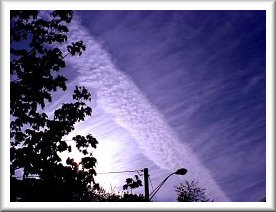 Mechanics
want to work on three things. The avionics, the engines, or the flight controls.
The mechanics that work on these systems are considered at the top of the "pecking
order". Next come the mechanics that work on the hydraulics and air conditioning
systems. Then come the ones who work on the galley and other non-essential systems.
But at the very bottom of the list are the mechanics that work on the waste
disposal systems. No mechanic wants to work on the pumps, tanks, and pipes that
are used to store the waste from the lavatories. But
at every airport where I have worked there are always 2 or 3 mechanics that
volunteer to work on the lavatory systems.
Mechanics
want to work on three things. The avionics, the engines, or the flight controls.
The mechanics that work on these systems are considered at the top of the "pecking
order". Next come the mechanics that work on the hydraulics and air conditioning
systems. Then come the ones who work on the galley and other non-essential systems.
But at the very bottom of the list are the mechanics that work on the waste
disposal systems. No mechanic wants to work on the pumps, tanks, and pipes that
are used to store the waste from the lavatories. But
at every airport where I have worked there are always 2 or 3 mechanics that
volunteer to work on the lavatory systems.
The
other mechanics are happy to let them do it. Because of this you will have only
2 or 3 mechanics that work on these systems at any one airport. No one pays
much attention to these guys and no mechanic socializes with another mechanic
who only works on the waste systems. In fact I had never thought much about
this situation until last month.
Like
most airlines we have reciprocal agreements with the other airlines that fly
into this airport. If they have a problem with a plane one of our mechanics
will take care of it. Likewise if one of our planes has a problem at an airport
where the other airline has a maintenance base, they will fix our plane.
One
day last month I was called out from our base to work on a plane for another
airline. When I got the call the dispatcher did not know what the problem was.
When I got to the plane I found out that the problem was in waste disposal system.
There was nothing for me to do but to crawl in and fix the problem. When I got
into the bay I realized that something was not right. There were more tanks,
pumps, and pipes then should have been there. At first I assumed that the system
had been changed. It had been 10 years since I had worked on one. As I tried
to find the problem I quickly realized the extra piping and tanks were not connected
to the waste disposal system. I had just discovered this when another mechanic
from my company showed up. It was one of the mechanics who usually works on
these systems. I happily turned the job over to him. As I was leaving I asked
him about the extra equipment. He told me to "worry about my end of the plane
and let him worry about his!"
The
next day I was on the company computer to look up a wiring schematic. While
I was there I decided to look up the extra equipment I had found. To my amazement
the manuals did not show any of the extra equipment I had seen with my own eyes
the day before. I even tied in to the manufacturer files and still found nothing.
Now I was really determined to find out what that equipment did.
The
next week we had three of our planes in our main hanger for periodic inspection.
There are mechanics crawling all over a plane during these inspections. I had
just finished my shift and I decided to have a look at the waste system on one
of our planes. With all the mechanics around I figured that no one would notice
an extra one on the plane. Sure enough, the plane I choose had the extra equipment!
I
began to trace the system of pipes, pumps, and tanks. I found what appeared
to be the control unit for the system. It was a standard looking avionics control
box but it had no markings of any kind. I could trace the control wires from
the box to the pumps and valves but there were no control circuits coming into
the unit. The only wires coming into the unit was a power connection to the
aircraft's main power bus.
The
system had 1 large and 2 smaller tanks. It was hard to tell in the cramped compartment
but it looked like the large tank could hold 50 gallons. The tanks were connected
to a fill and drain valve that passed through the fuselage just behind the drain
valve for the waste system. When I had a chance to look for this connection
under the plane I found it cunningly hidden behind a panel under the panel used
to access the waste drain.
I
began to trace the piping from the pumps. These pipes lead to a network of small
pipes that ended in the trailing edges of the wings and horizontal stabilizers.
If you look closely at the wings of a large airplane you will see a set of wires,
about the size of your finger, extending from the trailing edge of the wing
surfaces. These are the static discharge wicks. They are used to dissipate the
static electric charge that builds up on a plane in flight. I discovered that
the pipes from this mystery system lead to every 1 out of 3 of these static
discharge wicks. These wicks had been "hollowed out" to allow whatever flows
through these pipes to be discharged through these fake wicks.
It
was while I was on the wing that one of the managers spotted me. He ordered
me out of the hanger telling me that my shift was over and I had not been authorized
any overtime.
The
next couple of days were very busy and I had no time to continue my investigation.
Late one afternoon, two days after my discovery, I was called to replace an
engine temperature sensor on a plane due to take off in two hours. I finished
the job and turned in the paperwork.
About
30 minutes later I was paged to see the General Manager. When I went in his
office I found that our union rep and two others who I did not know were waiting
on me. He told me that a serious problem had been discovered. He said that I
was being written up and suspended for turning in false paperwork. He handed
me a disciplinary form stating that I had turned in false paperwork on the engine
temperature sensor I had installed a few hours before. I was floored and began
to protest. I told them that this was ridiculous and that I had done this work.
The union rep spoke up then and recommended that we take a look at the plane
and see if we could straighten it all out. It was at this time that I asked
who the other two men were. The GM told me that they were airline safety inspectors
but would not give me their name.
We
proceeded to the plane, which should have been in the air but was parked on
our maintenance ramp. We opened the engine cowling and the union rep pulled
the sensor. He checked the serial number and told everyone that it was the old
instrument. We then went to the parts bay and went back into the racks. The
union rep checked my report and pulled from the rack a sealed box. He opened
the box and pulled out the engine temperature sensor with the serial number
of the one I had installed. I was told that I was suspended for a week without
pay and to leave immediately.
I
sat at home the first day of my suspension wondering what the hell had happened
to me. That evening I received a phone call. The voice told me "Now you know
what happens to mechanics who poke around in things they shouldn't. The next
time you start working on systems that are no concern of yours you will lose
your job! As it is I'm feeling generous, I believe that you'll be able to go
back to work soon" CLICK. Again I had to pick myself from off the floor.
I made the connection that what had happened was directly connected to my tracing
the mysterious piping. The next morning the General Manager called me. He said
that due to my past excellent employment record that the suspension had been
reduced to one day and that I should report back to work immediately. The only
thing I could think of was what are they trying to hide and who are THEY!
That
day at work went by as if nothing had happened. None of the other mechanics
mentioned the suspension and my union rep told me not to talk about it. That
night I logged onto the Internet to try to find some answers. I don't remember
now how I got there but I came across a site dealing with chemtrails. That's
when it all came together. But the next morning at work I found a note inside
my locked locker. It said, "Curiosity killed the cat. Don't be looking at
Internet sites that are no concern of yours."
Well
that's it. THEY are watching me.
Well
you already know what they are doing. I don't know what they are spraying but
I can tell you how they are doing it. I figure they are using the "honey
trucks". These are the trucks that empty the waste from the lavatory waste
tanks. The airports usually contract out this job and nobody goes near these
trucks. Who wants to stand next a truck full of sh--. While these guys are emptying
the waste tanks they are filling the tanks of the spray system. They know the
planes flight path so they probably program the control unit to start spraying
some amount of time after the plane reaches a certain altitude. The spray nozzles
in the fake static wicks are so small that no one in the plane would see a thing.
NB:
We found it interesting that our site received a visit from Boeing within 4
HOURS of this article appearing on the web! - Another case of Echelon at work???
Wanna
find out more about Chemtrails??? Click on the banner below.


 Chemtrails
are a new phenomena which has struck all over the world. It seems that the government
are using planes to spray populated areas with a chemical solution, which can
make people very sick, but why??. Normal contrails usually dissipate very rapidly,
are of relatively short length, and show variability in their formation from
the engines. Chemtrails usually extend continuously and expand to transform
into a cirrus type cloud layer. Apart from the repeated, intense, and unusual
flight-patterns, odd illnesses will sometimes strike people shortly after these
chemtrail episodes; multiple witnesses have also reported a cobweb-like substance
seen falling from the sky.
Chemtrails
are a new phenomena which has struck all over the world. It seems that the government
are using planes to spray populated areas with a chemical solution, which can
make people very sick, but why??. Normal contrails usually dissipate very rapidly,
are of relatively short length, and show variability in their formation from
the engines. Chemtrails usually extend continuously and expand to transform
into a cirrus type cloud layer. Apart from the repeated, intense, and unusual
flight-patterns, odd illnesses will sometimes strike people shortly after these
chemtrail episodes; multiple witnesses have also reported a cobweb-like substance
seen falling from the sky.
 These
normally manifest as billowy smoke trails when viewed from the ground, and tend
to always become broader and denser over time. They generally do not evaporate,
nor do they dissipate at all. Over a period of several hours, parallel ChemTrail
formations will eventually spread out to meet one another and join together to
form a continuous, banded, cirrus-like cloud formation in the sky. Often a fish-spine
configuration will be observed after a given ChemTrail has had sufficient time
to mature. Shortly after this joining-up phase, what just hours earlier was a
perfectly clear blue sky, will now appear as a structured, milky-haze overcast,
unnatural in all respects.
These
normally manifest as billowy smoke trails when viewed from the ground, and tend
to always become broader and denser over time. They generally do not evaporate,
nor do they dissipate at all. Over a period of several hours, parallel ChemTrail
formations will eventually spread out to meet one another and join together to
form a continuous, banded, cirrus-like cloud formation in the sky. Often a fish-spine
configuration will be observed after a given ChemTrail has had sufficient time
to mature. Shortly after this joining-up phase, what just hours earlier was a
perfectly clear blue sky, will now appear as a structured, milky-haze overcast,
unnatural in all respects.
 The
type of aircraft that are most frequently observed laying-down genuine ChemTrail
patterns, are normally KC-10A or KC-135 tankers.
The KC-10A is a three-engine aircraft and would therefore normally leave a three-element
parallel contrail in its wake. The KC-135 however, is a smaller, four-engine
aircraft, and would therefore typically display four-element contrail. When
used during ChemTrail missions however, these aircraft have been observed laying-down
only a thick and billowy, single-element ChemTrail, while simultaneously displaying
no concurrent normal contrail activity. Two different mechanisms
are therefore at work here.
The
type of aircraft that are most frequently observed laying-down genuine ChemTrail
patterns, are normally KC-10A or KC-135 tankers.
The KC-10A is a three-engine aircraft and would therefore normally leave a three-element
parallel contrail in its wake. The KC-135 however, is a smaller, four-engine
aircraft, and would therefore typically display four-element contrail. When
used during ChemTrail missions however, these aircraft have been observed laying-down
only a thick and billowy, single-element ChemTrail, while simultaneously displaying
no concurrent normal contrail activity. Two different mechanisms
are therefore at work here.
 This
pattern-configuration feature can serve as a very good guide in helping to distinguish
between normal contrail observations and true ChemTrails sightings, but it is
not foolproof. The military has been equipping their KC-10As and KC-135s with
wing tip mounted refueling pods, to permit multiple, simultaneous refueling
operations. If one of these aircraft is being used in a particular ChemTrail
mission, then the resulting dispersion will most likely start out as two-parallel
emissions. Eventually though, these will merge into a single wide-band dispersion
pattern, retaining all of the other special characteristics associated with
ChemTrail activity.
This
pattern-configuration feature can serve as a very good guide in helping to distinguish
between normal contrail observations and true ChemTrails sightings, but it is
not foolproof. The military has been equipping their KC-10As and KC-135s with
wing tip mounted refueling pods, to permit multiple, simultaneous refueling
operations. If one of these aircraft is being used in a particular ChemTrail
mission, then the resulting dispersion will most likely start out as two-parallel
emissions. Eventually though, these will merge into a single wide-band dispersion
pattern, retaining all of the other special characteristics associated with
ChemTrail activity.
 One
more distinguishing characteristic of a ChemTrail than can help to separate
these from normal contrails concerns the display of a vertical curtain-like
fall-off from a maturing ChemTrail. Although the ChemTrail remains very prominent
in the sky, the vertical curtain seems to roll off of the main body and appears
to descend toward the surface in vertical sheets. The
essential idea to keep in mind regarding ChemTrails, regardless of the manner
in which these bio-chemical agents are being dispersed, is that all ChemTrails
eventually coalesce into a consistent, widely diffused footprint, which ultimately
obscures all or most of the entire sky with a clearly structured, solid milky
haze.
One
more distinguishing characteristic of a ChemTrail than can help to separate
these from normal contrails concerns the display of a vertical curtain-like
fall-off from a maturing ChemTrail. Although the ChemTrail remains very prominent
in the sky, the vertical curtain seems to roll off of the main body and appears
to descend toward the surface in vertical sheets. The
essential idea to keep in mind regarding ChemTrails, regardless of the manner
in which these bio-chemical agents are being dispersed, is that all ChemTrails
eventually coalesce into a consistent, widely diffused footprint, which ultimately
obscures all or most of the entire sky with a clearly structured, solid milky
haze.
 We
can summarize the characteristic pattern-configuration behavioral of genuine
ChemTrail activity with the following two statements: First, that the aircraft
used in these operations tend to be flown at altitudes below 31,000
feet, because no normal engine-related contrails are ever observed concurrent
with the emission of the ChemTrails. Secondly, that the biochemical agent forming
these ChemTrails is being emitted by a mechanical component of the aircraft
other than the engines—normally, this component is the single, extended, rear
mounted, refueling tail-boom.
We
can summarize the characteristic pattern-configuration behavioral of genuine
ChemTrail activity with the following two statements: First, that the aircraft
used in these operations tend to be flown at altitudes below 31,000
feet, because no normal engine-related contrails are ever observed concurrent
with the emission of the ChemTrails. Secondly, that the biochemical agent forming
these ChemTrails is being emitted by a mechanical component of the aircraft
other than the engines—normally, this component is the single, extended, rear
mounted, refueling tail-boom.  When
sunlight passes through a ChemTrail, the chemical components making up the cloud
tend to refract sunlight in such a way as to render a yellow-orange-green halo
surrounding the sun at a distance of about 20 to 30 degrees of radius on either
side. Some researchers have indicated that this is best observed using polarized
sunglasses, but it can generally be seen with or without a filter. This halo
is not always completely circular and continuous, but may on occasion, depending
on the structure of the ChemTrails, be expressed as colored prominences at irregular,
and scattered distances from the sun.
When
sunlight passes through a ChemTrail, the chemical components making up the cloud
tend to refract sunlight in such a way as to render a yellow-orange-green halo
surrounding the sun at a distance of about 20 to 30 degrees of radius on either
side. Some researchers have indicated that this is best observed using polarized
sunglasses, but it can generally be seen with or without a filter. This halo
is not always completely circular and continuous, but may on occasion, depending
on the structure of the ChemTrails, be expressed as colored prominences at irregular,
and scattered distances from the sun.
 When
the camouflage is not working properly though, or the fallout is particularly
dense, you will definitely smell something very strange, that you have probably
never sensed before. It has been described by some observers as a metallic
or corrosive odor. Although we have also picked up the scent from
time to time, particularly in the early morning when the air is still, labeling
it is an altogether different matter. The closest comparable odor would be malathion,
which just so happends to be a pesticide! When you do finally meet up with it,
you will know it—the odor is very difficult to forget afterwards.
When
the camouflage is not working properly though, or the fallout is particularly
dense, you will definitely smell something very strange, that you have probably
never sensed before. It has been described by some observers as a metallic
or corrosive odor. Although we have also picked up the scent from
time to time, particularly in the early morning when the air is still, labeling
it is an altogether different matter. The closest comparable odor would be malathion,
which just so happends to be a pesticide! When you do finally meet up with it,
you will know it—the odor is very difficult to forget afterwards.
 Mechanics
want to work on three things. The avionics, the engines, or the flight controls.
The mechanics that work on these systems are considered at the top of the "pecking
order". Next come the mechanics that work on the hydraulics and air conditioning
systems. Then come the ones who work on the galley and other non-essential systems.
But at the very bottom of the list are the mechanics that work on the waste
disposal systems. No mechanic wants to work on the pumps, tanks, and pipes that
are used to store the waste from the lavatories. But
at every airport where I have worked there are always 2 or 3 mechanics that
volunteer to work on the lavatory systems.
Mechanics
want to work on three things. The avionics, the engines, or the flight controls.
The mechanics that work on these systems are considered at the top of the "pecking
order". Next come the mechanics that work on the hydraulics and air conditioning
systems. Then come the ones who work on the galley and other non-essential systems.
But at the very bottom of the list are the mechanics that work on the waste
disposal systems. No mechanic wants to work on the pumps, tanks, and pipes that
are used to store the waste from the lavatories. But
at every airport where I have worked there are always 2 or 3 mechanics that
volunteer to work on the lavatory systems.

